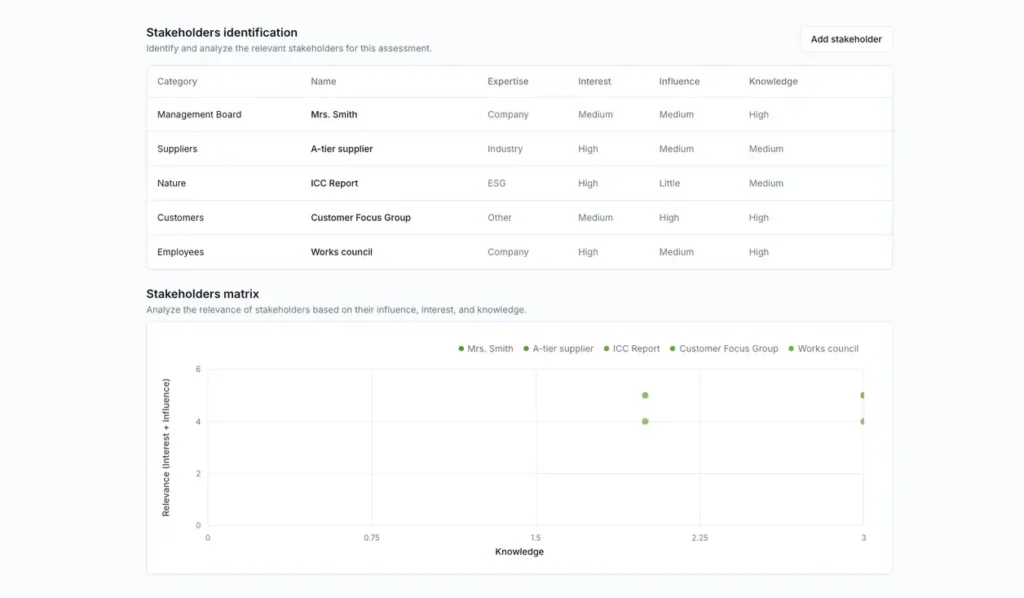Stakeholder analysis has become an essential tool for companies navigating the complexities of modern sustainability reporting. As businesses face increasing regulatory pressure under the Corporate Sustainability Reporting Directive (CSRD) and European Sustainability Reporting Standards (ESRS), the need for robust stakeholder engagement is greater than ever. These new reporting frameworks have introduced the concept of double materiality, which emphasizes both financial and environmental, social, and governance (ESG) impacts.
In this guide, we’ll explore the importance of stakeholder analysis in the context of double materiality, explain how it fits into your sustainability reporting framework, and provide practical steps and best practices for getting it right. Whether you’re new to the concept or looking to enhance your approach, this comprehensive guide will give you the tools to streamline your stakeholder analysis and align it with emerging regulatory requirements.
What is double materiality and why is stakeholder analysis important?
Double materiality is the foundation of modern ESG reporting under the CSRD. It requires companies to assess materiality from two perspectives:
- Financial Materiality: How sustainability issues, such as climate risks, might impact the financial performance of your business.
- Impact Materiality: How your business activities affect the environment, society, and the broader stakeholder community.
Unlike traditional materiality, which focuses solely on financial risks, double materiality incorporates a broader spectrum of impacts. This means businesses must assess not only how climate change and social issues impact their bottom line but also how their operations contribute to—or mitigate—those same challenges.
This shift requires businesses to engage with stakeholders to understand their concerns. That’s where stakeholder analysis comes into play. Stakeholder analysis is the process of identifying, prioritizing, and engaging key groups who are affected by or have an influence on your business. These groups include employees, customers, local communities, suppliers, shareholders, NGOs, regulatory bodies, and even nature, which is sometimes referred to as a “silent stakeholder.”
By systematically gathering stakeholder insights, companies can ensure that their double materiality assessments capture the most relevant issues, making their sustainability reports more credible, actionable, and aligned with stakeholder expectations.
The ESRS recommends an active exchange with relevant stakeholders, but does not make this mandatory. However, the concerns of stakeholders must be taken into account:
“Materiality assessment is informed by dialogue with affected stakeholders. The undertaking may engage with affected stakeholders or their representatives (such as employees or trade unions), along with users of sustainability reporting and other experts, to provide inputs or feedback on its conclusions regarding its material impacts, risks and opportunities.” (cf. ESRS 1, Appendix A, AR 8, 2023)
Why stakeholder analysis is central to double materiality
Stakeholder analysis is central to the success of double materiality assessments for several reasons:
- Broader Perspective: Stakeholders often see issues that companies may overlook. By gathering input from diverse stakeholder groups, businesses can identify risks and opportunities that might not be immediately apparent through financial data alone.
- Regulatory Compliance: Under the CSRD and ESRS, companies are required to report on their impact on various stakeholder groups. Failing to consider these perspectives may lead to incomplete or non-compliant sustainability reports.
- Building Trust: Stakeholders increasingly expect transparency. By engaging them directly, companies can demonstrate that they are responsive to the concerns of employees, customers, communities, and other key groups. This builds trust and strengthens relationships.
- Future-Proofing: Stakeholder engagement helps companies stay ahead of emerging trends. Issues that may seem minor today could evolve into major risks tomorrow. By maintaining an ongoing dialogue with stakeholders, companies can anticipate changes and adapt their strategies accordingly.
Key steps in conducting stakeholder analysis
A well-executed stakeholder analysis allows companies to gather valuable insights that inform both financial and impact materiality. Below are the key steps to conducting a stakeholder analysis:
1. Identifying and prioritizing stakeholders
The first step is to identify all stakeholders who are relevant to your business. These may include internal stakeholders (employees, management, shareholders) and external groups (customers, suppliers, communities, regulatory bodies, NGOs, and environmental stakeholders). It’s important to consider both direct stakeholders, who are immediately affected by your business activities, and indirect stakeholders, who may be impacted by long-term outcomes such as climate change or social inequality.
Once identified, stakeholders should be prioritized based on:
- Influence: How much power or influence they have over your business decisions? And how much influence do you have on the stakeholders?
- Interest: How much are they impacted by or interested in your business?
- Knowledge: How well do you know this stakeholder and its needs?
A simple stakeholder matrix, mapping relevance (influence and interest) against knowledge, can help visualize which stakeholders should be engaged more intensely and whose feedback might carry more weight.

Don’t know where to start? Don’t worry! The Materiality Master guides you through this process and creates a stakeholder matrix automatically. You can sign-up for free and test the Materiality Master for 7 days.
2. Engaging stakeholders and collecting feedback
The next step is engaging stakeholders to gather their insights on the issues that matter most to them. We differentiate between direct or active engagement and indirect or passive engagement.
During these engagements, companies should focus on identifying ESG topics that stakeholders perceive as high-priority. It’s essential to get answers to the right questions, such as:
- What are the key environmental, social, or governance issues that concern this stakeholder group most?
- Is our list of potential material topics complete or are we missing anything?
- How does our business impact these areas?
- Do you agree with our rating of the IROs (impacts, risks, and opportunities) relevant to you?
- How can we improve our practices to better meet stakeholder expectations?
Direct stakeholder engagement methods
Directly engaging with stakeholders can be done through a variety of methods, including:
- Surveys (digital or in-person)
- Interviews
- Focus groups
- Workshops
- Public forums for communities and larger groups
Each of these methods has its pros and cons. For example, surveys are scalable and allow for quantitative analysis, while interviews and focus groups offer deeper qualitative insights. The cost-benefit analysis is always central to the decision to involve stakeholders. Direct involvement should therefore provide significant added value.
Indirect stakeholder engagement methods
While engaging with stakeholders directly is perfect to answer exactly your questions, it is also very time-consuming. The ESRS demands organizations to consider stakeholder perspectives. This can also be achieved more effectively. Here are a few ideas:
- Annual employee survey: Review and leverage the results of your annual HR survey to spot the most pressing topics of your workforce.
- Climate reports: Nature is a silent stakeholder. It can’t really speak for itself. You can either ask nature NGOs to speak on behalf of nature or you can analyse official climate reports, eg. IPCC Report, and use it’s data to justify your IRO ratings.
- Ratings and certificates: Imagine you have to assess certain aspects of your suppliers. Check if they have trustworthy certificates or ratings that can serve as evidence to support your arguments.
There are many more effective options to take into account the views of your stakeholders without the need to actively engage with them.
3. Analyzing and prioritizing stakeholder input
Once feedback is collected, it’s time to analyze and prioritize the insights. Stakeholders may highlight a range of issues, from climate risk and carbon emissions to labor rights and community engagement. To prioritize these issues, you’ll need to assess:
- Frequency: How often specific issues are mentioned by multiple stakeholders.
- Severity: The potential magnitude of the impact on your stakeholders or your business.
- Alignment: How these issues align with your company’s long-term strategic goals and regulatory requirements.
This process allows you to identify the most material topics, ensuring that your sustainability report contains the relevant ESRS data points to address the concerns that matter most to both your business and its stakeholders.
Stakeholder analysis in practice: tools and best practices
Conducting stakeholder analysis can be a complex and time-consuming task, but it doesn’t have to be. Materiality assessment tools like Materiality Master simplify the process by providing frameworks for identifying and engaging stakeholders and mapping their feedback to the most relevant ESG data points. With these double materiality assessment software solutions, companies can streamline the stakeholder engagement process, ensuring their double materiality assessments are based on comprehensive and accurate stakeholder input.
Best practices for Stakeholder Analysis:
- Start early: Don’t wait until the reporting season to engage with stakeholders. Start early in the process to ensure that their feedback is reflected in your materiality analysis.
- Prioritize: If possible, use internal stakeholders and make use of offers from your industry associations to involve them as stakeholders in the dual materiality analysis process. Active interaction with too many external stakeholders can slow down the process considerably.
- Tailor your engagement: Different stakeholders require different engagement methods. Adapt your approach to the specific needs and preferences of each group.
- Be transparent: Make sure stakeholders know how their feedback will be used. Transparency builds trust and encourages more meaningful participation.
- Continuous engagement: Stakeholder analysis is not a one-time exercise. Maintain ongoing engagement to stay updated on emerging issues and trends that could affect your materiality assessments.
- Collaborate with industry competitors: It can be beneficial to collaborate with Industry Competitors to jointly gather stakeholder feedback. This approach reduces the burden on stakeholders, minimizes redundant requests, and ensures higher-quality responses.
The role of stakeholder analysis in CSRD and ESRS compliance
As part of the CSRD implementation, stakeholder analysis is no longer optional. Businesses are required to consider the perspectives of key stakeholder groups when identifying material issues. This means that companies must demonstrate that they have actively engaged with stakeholders and considered their concerns when assessing both financial and impact materiality.
Failing to conduct thorough stakeholder analysis could result in non-compliance with these regulatory standards, leading to penalties or reputational damage. By integrating stakeholder analysis into your sustainability strategy, you can ensure that your reports meet regulatory requirements while also building stronger relationships with the people who matter most to your business.
Conclusion: the future of stakeholder analysis in double materiality
As sustainability becomes a cornerstone of business strategy, stakeholder analysis will continue to play an increasingly important role in shaping how companies assess their impact on the world around them. By mastering stakeholder analysis and integrating it into your double materiality assessments, you can stay ahead of regulatory requirements, build trust with stakeholders, and create a more resilient and sustainable business.
With the right tools and best practices – such as those offered by Materiality Master – you can streamline the process, ensuring that your sustainability reports not only comply with CSRD and ESRS but also reflect the issues that truly matter to your stakeholders. Whether you’re just starting your sustainability journey or looking to refine your approach, stakeholder analysis is a critical component of a successful double materiality strategy.


